You probably don’t realize that Alabama’s native plants can survive droughts lasting 60-90 days without supplemental watering, unlike most non-native species that require constant irrigation. These hardy survivors have evolved over thousands of years to handle the state’s unpredictable weather patterns, from scorching 95°F summers to occasional ice storms. Once you understand which specific natives match your soil type and sun exposure, you’ll discover why experienced gardeners consider them the ultimate low-maintenance solution.
Contents
- 1 Alabama’s Diverse Climate Zones
- 2 Alabama’s Best Native Wildflowers
- 3 Alabama’s Best Native Trees
- 4 Alabama’s Essential Native Shrubs
- 5 Selecting the Right Native Plants for Your Garden
- 6 Frequently Asked Questions
- 6.1 How Often Should I Water Newly Planted Native Alabama Plants?
- 6.2 When Is the Best Time to Plant Native Species in Alabama?
- 6.3 Do Alabama Native Plants Require Special Fertilizers or Soil Amendments?
- 6.4 How Do I Protect Native Plants From Common Alabama Pests and Diseases?
- 6.5 Where Can I Purchase Native Alabama Plants and Seeds Locally?
Alabama’s Diverse Climate Zones
When you’re planning a garden in Alabama, understanding the state’s climate zones becomes your roadmap to success. The state spans four distinct USDA zones, from 7b in northern regions to 9b along the coast. Northern Alabama’s cooler temperatures drop to 5°F, while coastal areas rarely dip below 20°F. This temperature gradient creates incredible plant diversity opportunities.
Climate adaptation varies dramatically across these zones, with northern plants needing cold tolerance and coastal species thriving in subtropical conditions. The updated zone map reflects climate change impacts with warmer temperatures across the state. Each zone supports different native communities, from mountain hardwoods to coastal prairie systems, giving you countless options for regional gardening success.
Alabama’s Best Native Wildflowers
Alabama’s diverse ecosystems support spectacular native wildflowers, from spring woodland blooms and pollinator magnets to drought-tolerant prairie species and shade-loving forest floor gems. These remarkable plants flourish across the state’s varied landscapes, from mountainous regions in the north to sandy coastal plains in the south.
Alabama Phlox
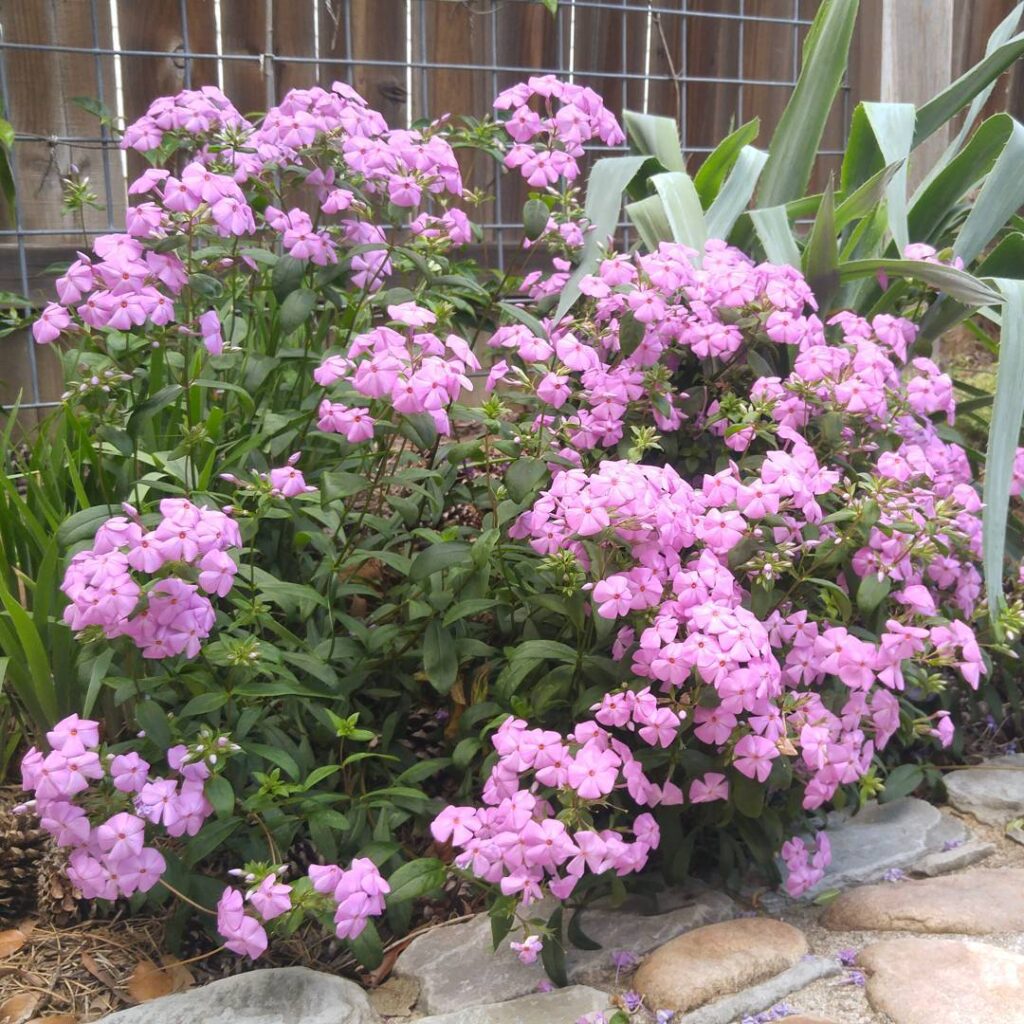
Alabama phlox (Phlox pulchra) stands as one of Alabama’s most treasured native wildflowers, found exclusively within the state’s borders. This rare perennial herb reaches about 2 feet tall with distinctive hairy purple stems and narrow evergreen foliage that provides year-round garden interest.
In spring, Alabama phlox produces stunning trumpet-shaped pink flowers that rise above the foliage, creating vibrant displays in woodland edges and glades. The showy blooms serve as essential early-season nectar sources for native pollinators including bees and butterflies, making this endemic species both ornamentally valuable and ecologically significant for maintaining local biodiversity. This species thrives in wood margins and openings where it can take advantage of filtered sunlight and natural soil conditions.
- Hardiness: Zones 7-9 (adapted to Alabama’s humid subtropical climate)
- Light: Partial sun to light shade
- Water: Moderate; tolerates seasonal rainfall variations once established
- Soil: Well-drained, sandy or rocky substrates preferred
- Fertilizer: Low requirements; avoid over-fertilization
- Pest/Disease Resistance: Good resistance when grown in appropriate conditions
- Growth Rate: Moderate; forms open clumps rather than dense mats
Wild Bergamot
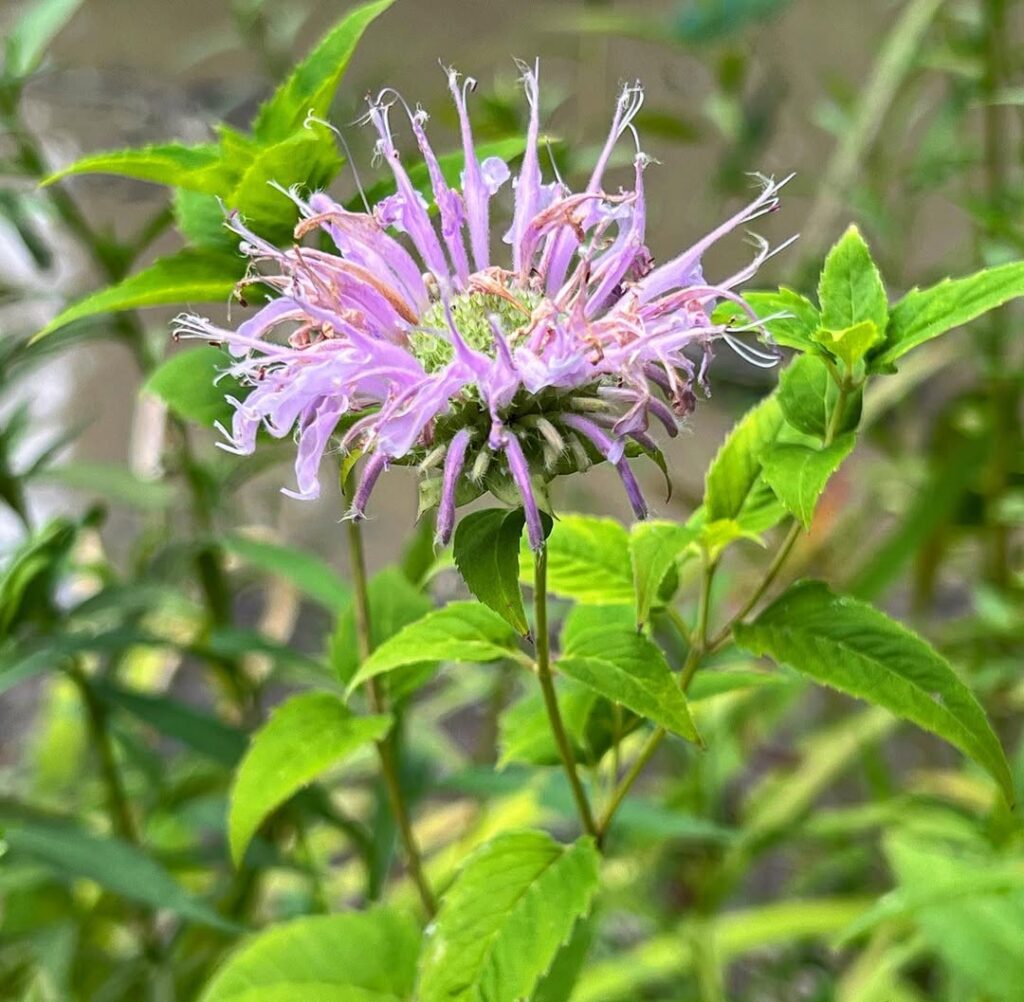
Wild Bergamot is a striking native perennial in the Mint family that produces clusters of lavender, pink, purple, or white ragged pompom-like flowers from May through September. Growing 4-5 feet tall with aromatic gray-green leaves, this versatile wildflower thrives in Alabama’s diverse habitats from prairies to open woods. Its flowers attract bees, butterflies, and hummingbirds, making it invaluable for pollinator gardens.
Historically used by Native Americans for medicinal teas and seasoning, Wild Bergamot’s leaves offer an oregano-thyme flavor profile. While drought-tolerant and low-maintenance once established, it spreads via rhizomes and requires periodic division every 2-3 years to prevent overcrowding and disease issues like powdery mildew. The plant produces distinctive brown nutlets as its fruit, which develop after the flowering period concludes.
- Hardiness: Zones 3-9, well-adapted to Alabama’s climate
- Light: Full sun to partial shade
- Water: Medium-moist to dry soils; drought tolerant once established
- Soil: Well-drained soils preferred; tolerates various soil types
- Fertilizer: Low fertilizer needs; thrives in average garden conditions
- Pest/Disease Resistance: Generally resistant; occasional powdery mildew in crowded conditions
- Growth Rate: Moderate to fast; spreads via rhizomes to form colonies
Wild Columbine
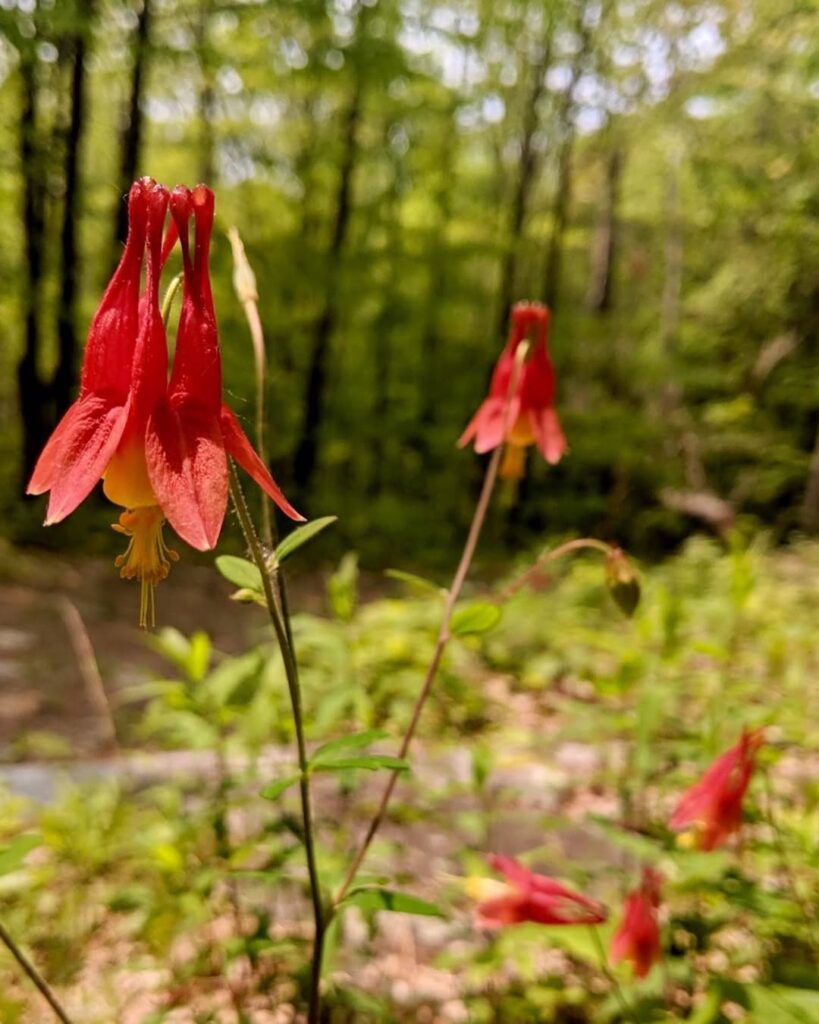
Wild Columbine (Aquilegia canadensis) stands as one of Alabama’s most cherished native wildflowers, bringing distinctive beauty to woodland gardens and natural areas. This herbaceous perennial showcases unique spur-shaped flowers in striking red and yellow combinations that hang gracefully downward from sparsely branched stems during mid to late spring.
Growing 12-24 inches tall with an upright, clumping form, Wild Columbine features attractive blue-green foliage with twice ternately compound leaves. The plant produces fascinating pod-shaped follicles that split open to release shiny black seeds, extending visual interest from spring through summer. As a member of the Buttercup family, this beloved wildflower attracts native pollinators while naturalizing beautifully in shaded garden settings. Wild Columbine provides excellent food for butterflies and supports hummingbirds seeking nectar from its distinctive blooms.
- Hardiness: USDA zones 3-8
- Light: Partial shade preferred, tolerates full sun with adequate moisture
- Water: Moist conditions preferred, tolerates occasional drought
- Soil: Well-draining clay, loam, or sand; adapts to alkaline soils
- Fertilizer: Low requirements, thrives in natural woodland conditions
- Pest/Disease Resistance: Generally resistant with good drainage
- Growth Rate: Medium, with slow to medium development
Black-eyed Susan
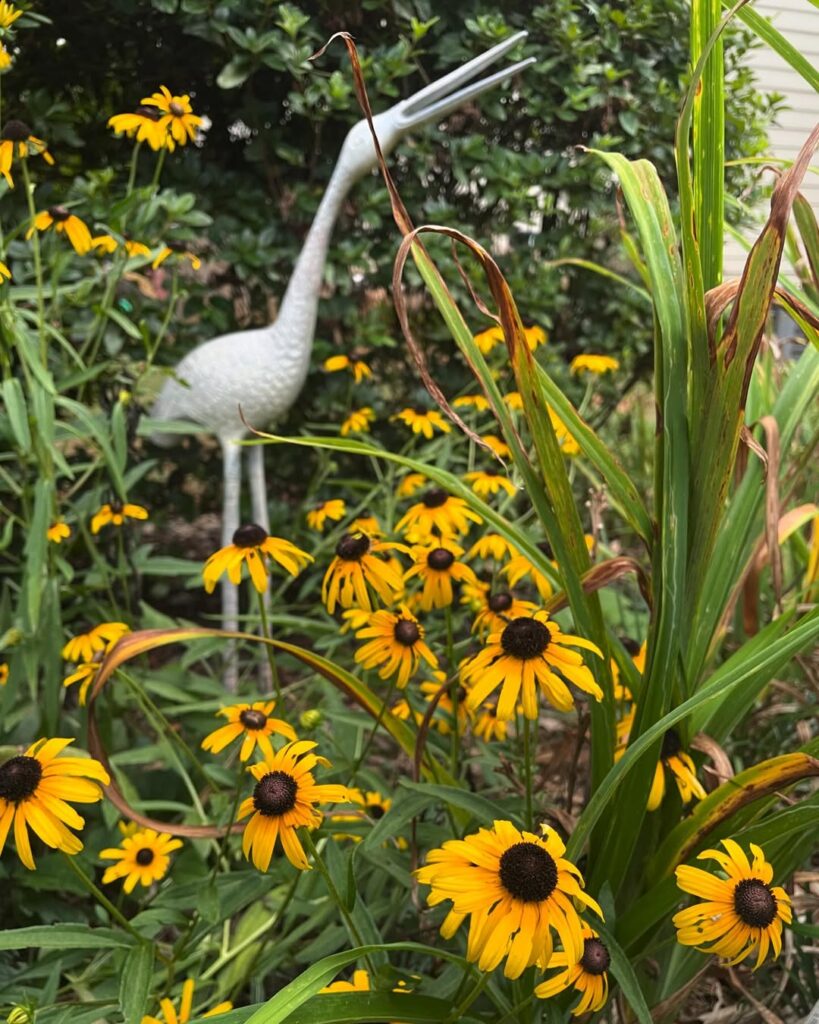
Black-eyed Susan (Rudbeckia hirta and Rudbeckia fulgida) stands as one of Alabama’s most beloved native wildflowers, bringing vibrant yellow blooms with distinctive dark brown centers to gardens and natural landscapes from June through October. This hardy perennial thrives in Alabama’s diverse habitats, from prairies and meadows to woodland edges and savannas.
Beyond its striking 2-inch diameter flowers and 12-36 inch height, Black-eyed Susan serves as a pollinator magnet, providing essential nectar for native bees and butterflies while offering seeds for birds. Its extended blooming period and low-maintenance nature make it invaluable for restoration projects, wildflower meadows, and naturalized landscapes throughout the Southeastern United States. The plant typically reaches 2-3 feet wide at maturity, creating substantial clumps that provide excellent coverage in naturalized settings.
- Hardiness: Thrives across Alabama and the broader Southeastern U.S.; naturalized across much of North America
- Light: Full to partial sun; ideal bloom with at least six hours of sunlight daily
- Water: Drought-tolerant but benefits from occasional irrigation during dry spells; tolerates moist to dry conditions
- Soil: Well-drained soils required; prefers acidic pH; does not tolerate high lime content
- Fertilizer: Low maintenance; thrives without heavy fertilization
- Pest/Disease Resistance: Excellent disease and pest resistance
- Growth Rate: Robust growth; can become aggressive in ideal conditions without adequate competition
Purple Coneflower
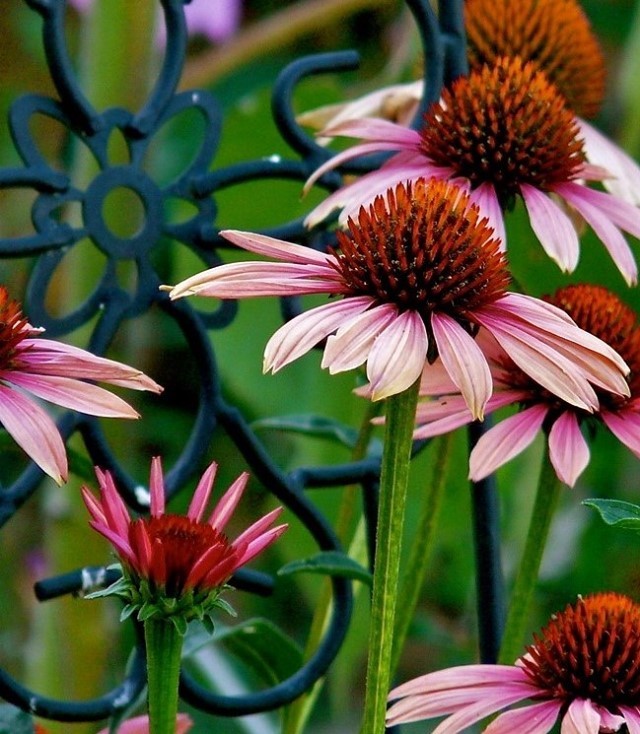
Purple Coneflower (Echinacea purpurea) is Alabama’s premier native wildflower, growing 2-4 feet tall with distinctive daisy-like blooms featuring drooping pinkish-purple petals and spiny orange centers. This robust perennial thrives from early to late summer, developing sturdy branching stems and heart-shaped basal leaves.
Named for its sea urchin-like center cone, Purple Coneflower serves as both an outstanding garden specimen and essential wildlife habitat, attracting butterflies, native bees, and goldfinches while providing exceptional drought tolerance and adaptability to various growing conditions. The plant supports Silvery Checkerspot butterflies and other specialized pollinators as a crucial food source.
- Hardiness: Perennial native to Alabama, cold hardy with excellent heat and humidity tolerance
- Light: Full sun (6+ hours daily) preferred, performs well in partial shade (2-6 hours)
- Water: Average watering requirements, excellent drought tolerance once established
- Soil: Well-drained soils including sandy, loamy, clay, or limestone-based types; tolerates poor soil conditions
- Fertilizer: Low maintenance, thrives without supplemental feeding in native conditions
- Pest/Disease Resistance: Excellent resistance, very few pest or disease problems
- Growth Rate: Moderate growth rate, develops substantial clumps over 3-4 years
Alabama’s Best Native Trees
Alabama’s diverse climate zones support over 100 native tree species, from the iconic longleaf pine to conservation-focused varieties and commercially valuable timber trees across distinct ecological regions. The University of Alabama’s Arboretum maintains an ongoing species list and map documenting these native collections for public education and research purposes.
Southern Magnolia
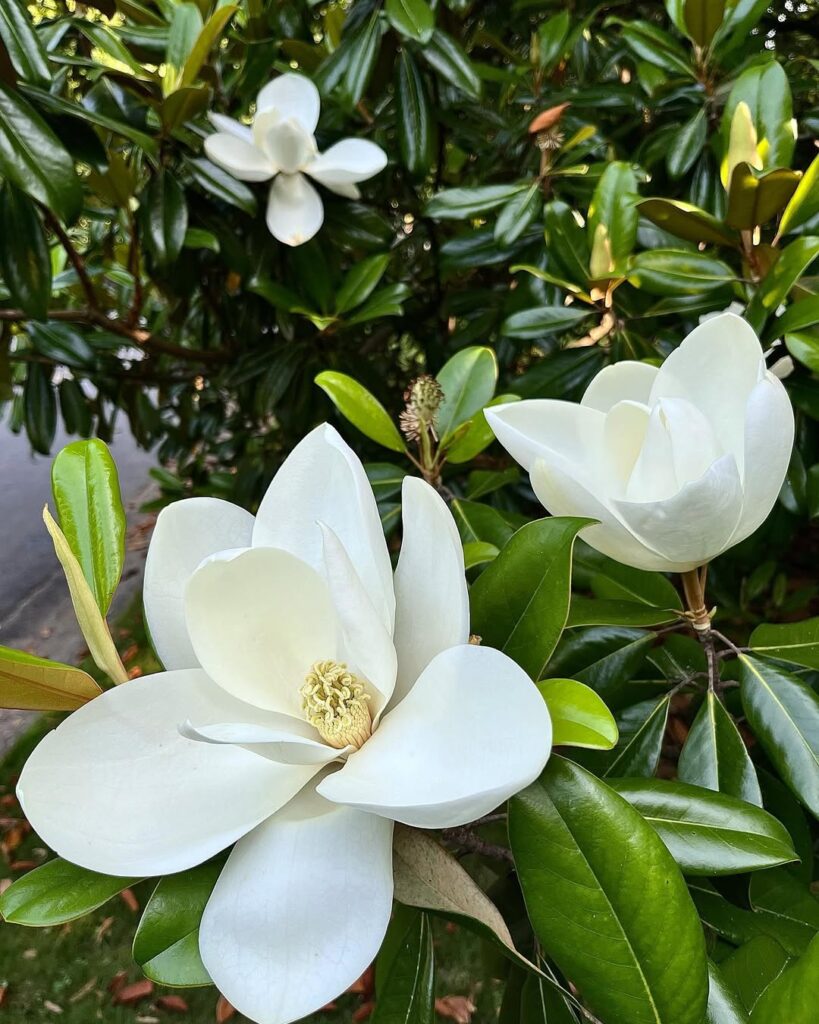
The Southern Magnolia is Alabama’s most iconic native evergreen tree, reaching impressive heights of 60-100 feet with glossy, dark-green leaves and a distinctive pyramidal crown. This majestic specimen produces spectacular fragrant white flowers up to 6 inches across from April to June, followed by cone-like fruits with bright red seeds.
Native to the southeastern Coastal Plain, the Southern Magnolia thrives throughout Alabama’s lowland and coastal regions. Its adaptability to various soil conditions and tolerance for both moisture and drought make it exceptionally well-suited to the state’s climate. The flowers exhibit a unique daily rhythm, opening around 9:00 A.M. and closing at night for 2-3 consecutive days before disintegrating. As a landscape tree, it provides excellent architectural interest and serves as a stunning specimen plant, though its coarse leaf litter requires occasional management.
- Hardiness: USDA zones covering Alabama’s climate; good cold tolerance with protection from harsh winter winds
- Light: Full sun to partial shade
- Water: Medium water usage; tolerates both dry and moist conditions
- Soil: Prefers rich, porous, acidic soils; adapts to sandy, loamy, clay, or calcareous substrates
- Fertilizer: Low maintenance once established
- Pest/Disease Resistance: Relatively pest-free with few disease issues
- Growth Rate: Fast-growing compared to other native Alabama trees
Southern Live Oak
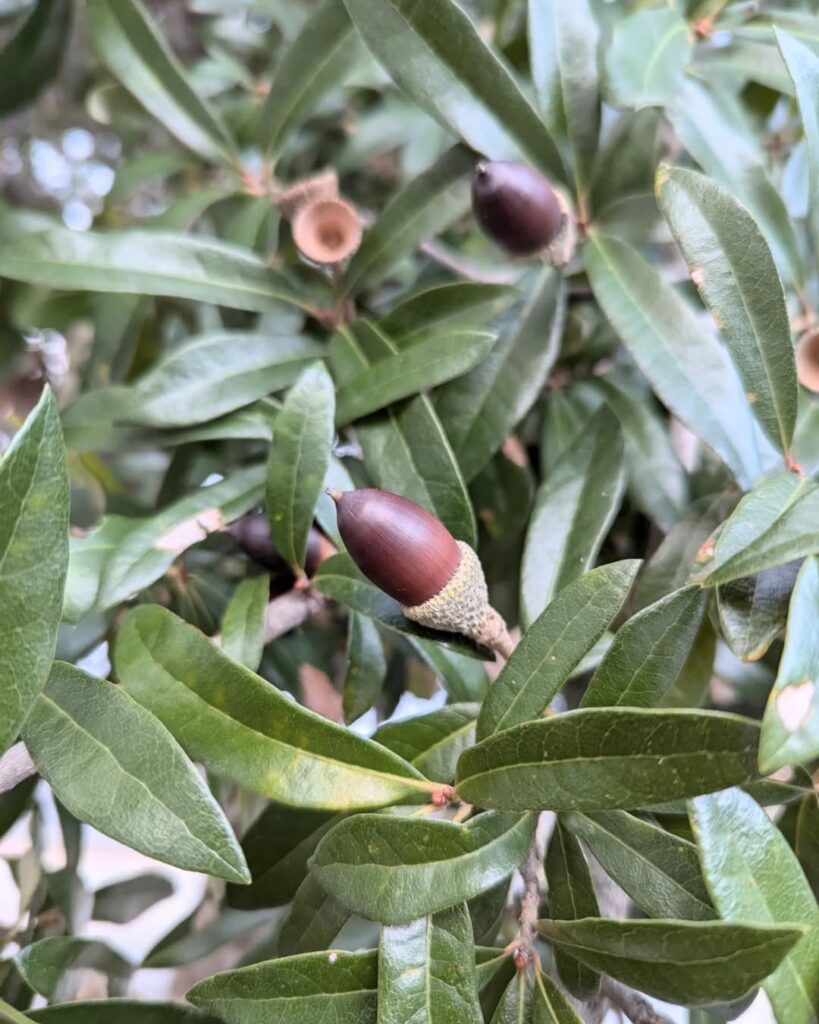
The Southern Live Oak (Quercus virginiana) stands as one of Alabama’s most iconic native trees, renowned for its majestic, sprawling canopy and distinctive evergreen foliage. This magnificent specimen typically reaches 40-80 feet in height with an impressive crown spread of 60-150 feet, creating extensive shade coverage. Its broad, rounded form and low-branching habit make it a commanding presence in the landscape.
Native to Alabama’s southernmost counties and throughout the southeastern United States, the Southern Live Oak thrives in the state’s coastal and central regions. The tree’s dark green, leathery leaves provide year-round visual interest, while its substantial trunk can reach up to 79 inches in diameter. Spanish moss frequently adorns its branches, enhancing the quintessential Deep South aesthetic that makes this species a beloved landscape focal point. The species demonstrates remarkable fire-resistant qualities due to its ability to survive crown and root damage while its dense canopy discourages flammable understory vegetation.
- Hardiness: USDA Zones 8-10
- Light: Full sun to partial sun
- Water: Regular watering; prefers moist conditions but drought tolerant once established
- Soil: Well-drained sandy soils and loams; adaptable to clay and alluvial soils; prefers acidic, rich soils
- Fertilizer: Low maintenance; minimal fertilization required
- Pest/Disease Resistance: Susceptible to root rot in poorly drained soils, oak wilt, and insect galls
- Growth Rate: Slow to moderate
Longleaf Pine
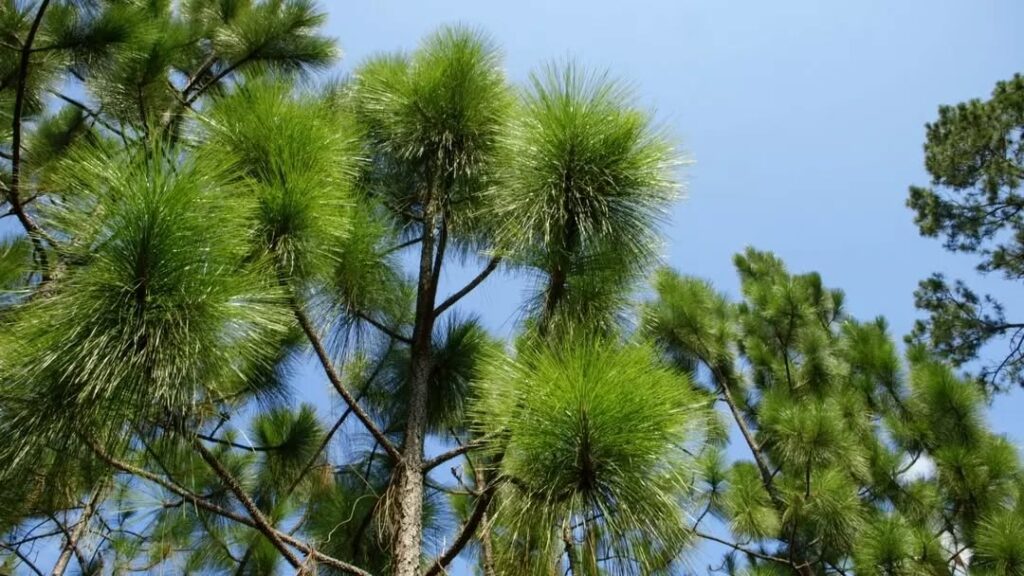
The longleaf pine stands as Alabama’s official state tree and a cultural symbol of the Southern United States. This distinctive evergreen conifer reaches 80-100 feet tall with characteristic 10-18 inch needles bundled in groups of three. Once spanning over 91 million acres across southeastern states, this species creates one of the most diverse understory ecosystems rivaling tropical forests, supporting nearly 200 associated plant species.
Fire plays an essential role in the longleaf pine’s life cycle, with seeds requiring direct soil contact to germinate and periodic burns maintaining the open understory characteristic of healthy longleaf habitats. Without regular fire, hardwoods and other pines invade and crowd out longleaf regeneration. Unfortunately, historic habitat loss from timber harvesting, urban development, and agriculture has reduced the original range by about two-thirds, leaving only small patches of this once-dominant ecosystem. Despite being the state tree, longleaf pine is now outnumbered by loblolly pine throughout Alabama.
- Hardiness: Native to southeastern United States, well-adapted to Alabama’s climate
- Light: Full sun (6+ hours of direct sunlight daily)
- Water: Average watering needs, drought tolerant once established
- Soil: Well-drained sandy, loamy, clay, or acidic soils; adaptable to various soil types
- Fertilizer: Low fertilizer requirements, adapted to nutrient-poor soils
- Pest/Disease Resistance: Generally resistant when grown in appropriate conditions
- Growth Rate: Slow to moderate growth rate
Southern Red Oak
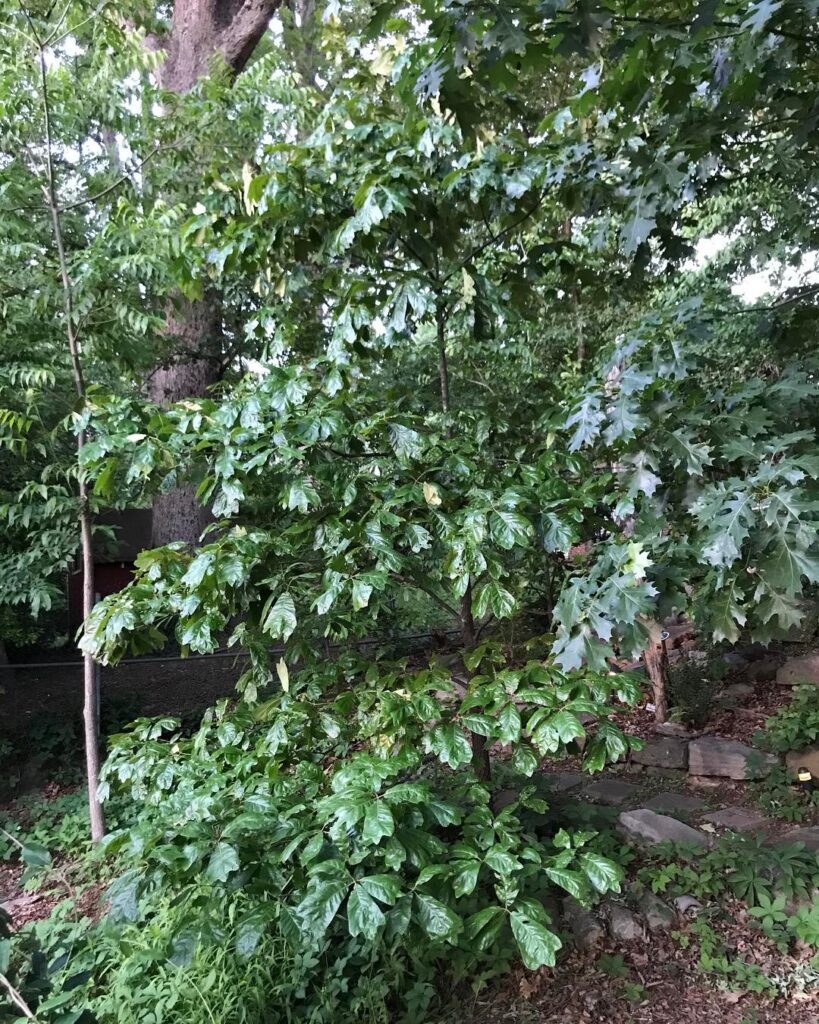
The Southern Red Oak (Quercus falcata), also known as Spanish oak, stands as one of Alabama’s premier native shade trees. This medium-sized deciduous beauty reaches 50-80 feet tall with distinctive 3-5 lobed leaves featuring sharply pointed, curved tips. Its dark brownish-gray bark develops deep furrows with age, while the trunk grows straight with well-spaced, strongly attached branches that resist breakage.
Prized for its drought tolerance and adaptability to Alabama’s variable climate, the Southern Red Oak thrives in diverse soil conditions from clay to sandy loam. Its rounded canopy provides excellent shade for residential and urban landscapes, while acorn production supports local wildlife. The tree’s durability and storm resistance make it ideal for areas experiencing occasional severe weather. Located in Tuscaloosa, the University of Alabama’s arboretum showcases native species like the Southern Red Oak daily from 8am.
- Hardiness: USDA zones 7A through 9B
- Light: Full sun exposure required for ideal growth
- Water: Drought tolerant once established; tolerates occasionally wet conditions
- Soil: Acidic, well-drained soils preferred; adapts to clay, sand, loam, sandy clay loam
- Fertilizer: Minimal requirements; benefits from organic matter in poor soils
- Pest/Disease Resistance: Generally resistant with good air circulation and proper spacing
- Growth Rate: Moderate to fast growth rate with proper conditions
Bald Cypress
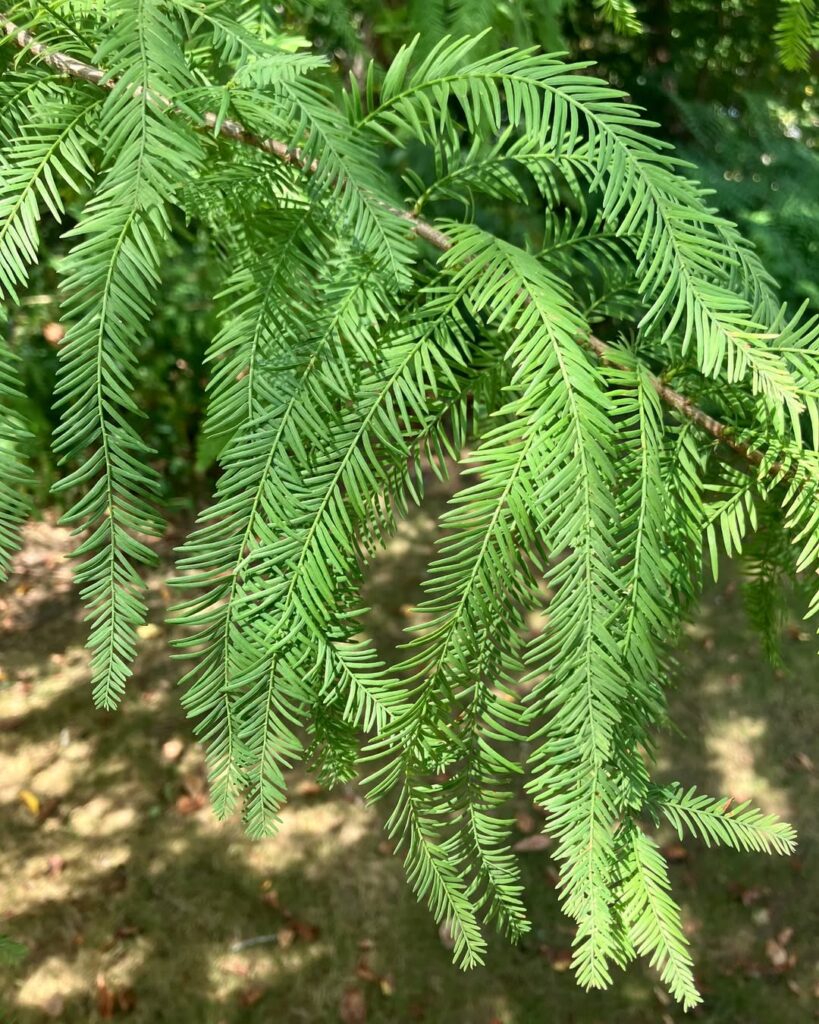
The Bald Cypress is Alabama’s magnificent native deciduous conifer, reaching impressive heights of 50-70 feet with distinctive reddish-brown exfoliating bark. This adaptable giant develops a pyramidal shape in youth before maturing into an irregular, flat-topped specimen with a dramatically widened base up to 6 feet in diameter.
Known for its seasonal transformation, this “bald” cypress displays lacy needles that turn beautiful russet-red in fall before dropping completely in winter. When grown near water, it produces characteristic conical “knees” from its root system, adding to its unique architectural appeal in the landscape.
This remarkable tree can live for centuries, with some specimens documented to be over 1,700 years old in ancient southeastern swamp forests.
- Hardiness: Zones 4-10, extremely durable and long-lived
- Light: Full sun to partial shade
- Water: Highly adaptable from wet/swampy to dry conditions; thrives in consistently moist to waterlogged soils
- Soil: Tolerates wide range including wet, salty, sandy, or clay soils; pH adaptable
- Fertilizer: Low maintenance; typically not required once established
- Pest/Disease Resistance: Excellent resistance; very few serious issues
- Growth Rate: Slow to moderate growth rate
Alabama’s Essential Native Shrubs
Alabama’s diverse native shrubs offer exceptional beauty, wildlife value, and climate adaptation. From fragrant spring bloomers to wildlife-supporting berry producers, these essential species enhance gardens while supporting local ecosystems. These shrubs adapt well to Alabama’s varied terrain, from the irregular plains of the Piedmont to the flat expanses of the Southeastern Plains.
Spicebush
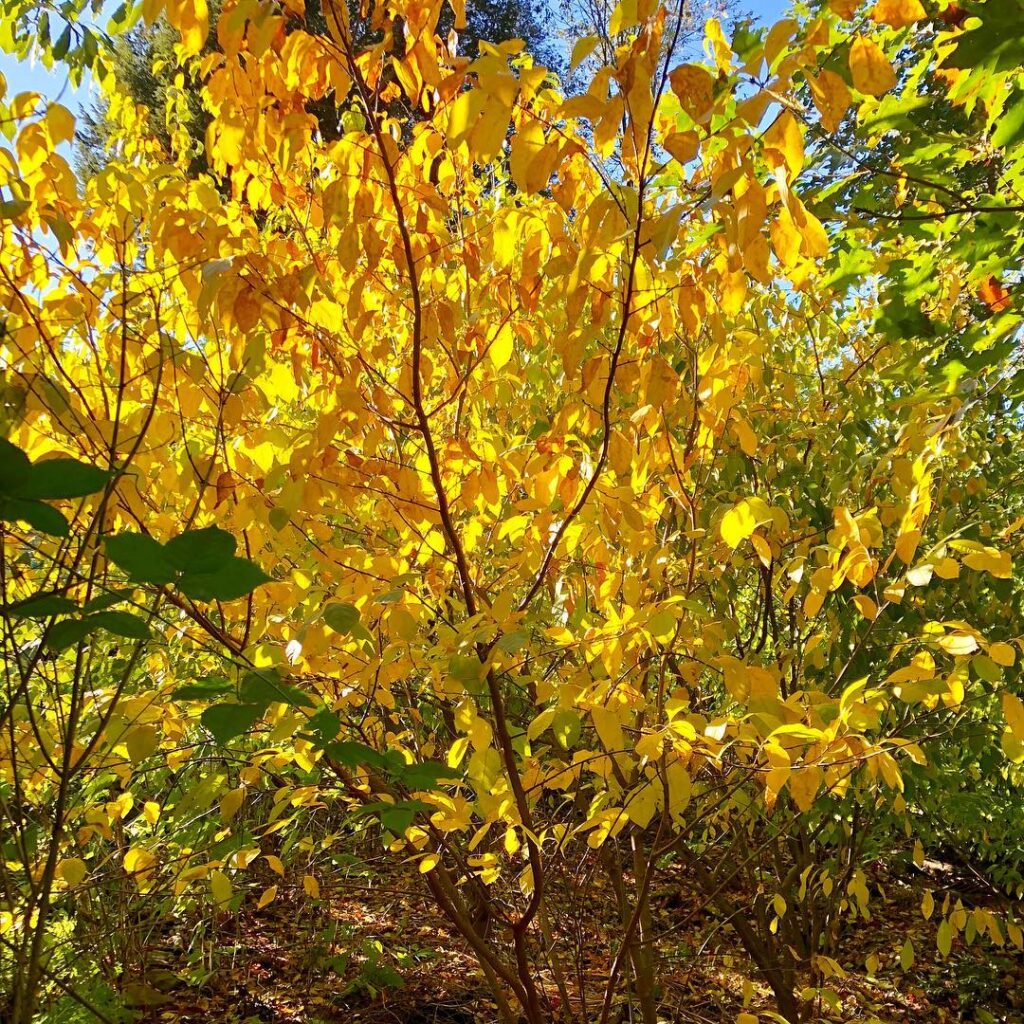
Spicebush (Lindera benzoin) is Alabama’s most essential native shrub, thriving throughout the state as Smooth Northern Spicebush. This aromatic member of the Laurel family creates stunning woodland displays with its small yellow spring flowers that form a soft haze before leaves emerge. Growing 6-12 feet tall with an irregular, multi-stemmed form, spicebush provides year-round interest through its fragrant foliage, bright red berries on female plants, and brilliant yellow fall color.
Beyond its ornamental value, spicebush serves as a critical wildlife plant, hosting the Spicebush Swallowtail butterfly and providing berries for birds. Its adaptability to various soil conditions and tolerance for both shade and sun make it invaluable for naturalizing woodland gardens, stream banks, and understory plantings throughout Alabama’s diverse landscapes. The plant features distinctive brown to gray-brown bark with lenticels, while new stems emerge as light green with a characteristic spicy fragrance.
- Hardiness: USDA Zones 4-9
- Light: Partial shade preferred, tolerates full sun with adequate moisture
- Water: Medium to wet requirements, prefers consistent moisture
- Soil: Moist, sandy, well-drained preferred; adapts to caliche, limestone-based, sandy loam, and medium loam
- Fertilizer: None required, thrives in native soil conditions
- Pest/Disease Resistance: No serious disease or insect problems
- Growth Rate: Fast-growing
Southern Wax Myrtle
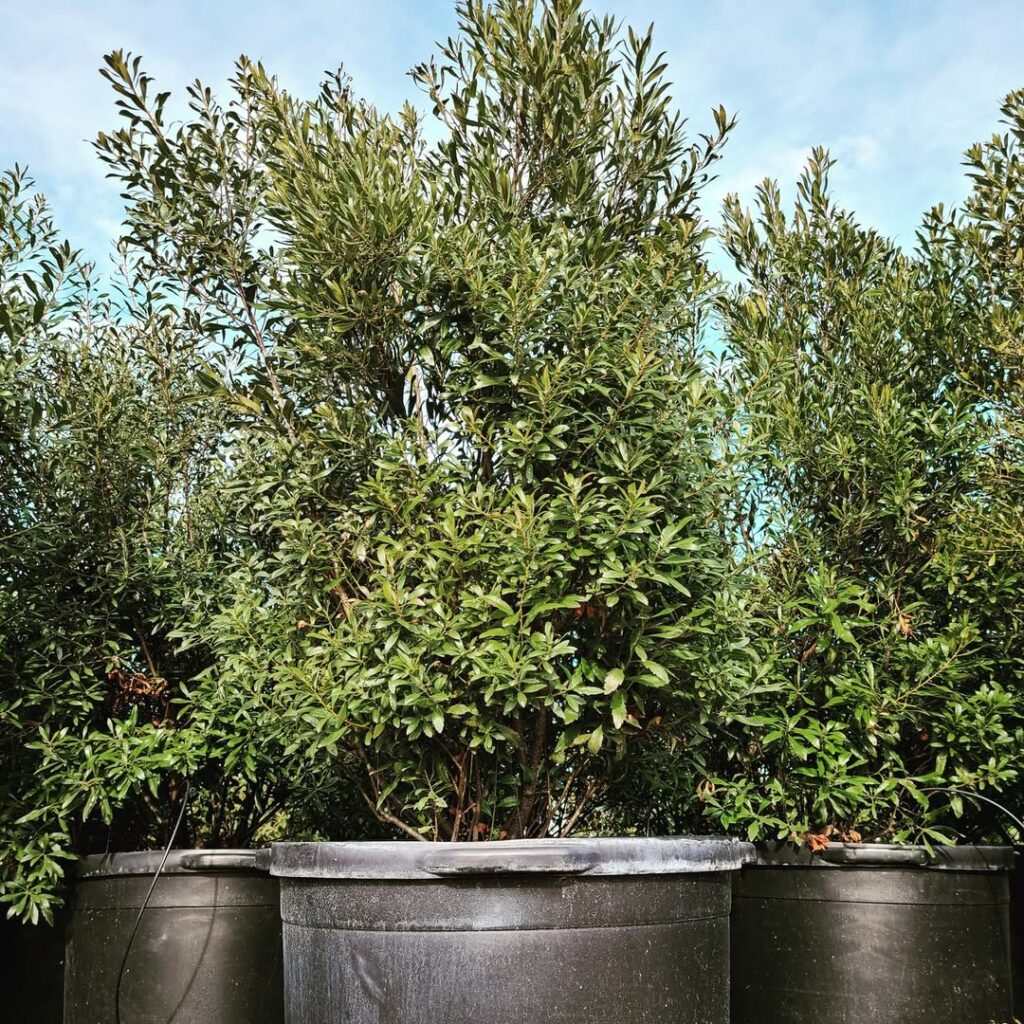
Southern Wax Myrtle is a versatile evergreen native that serves as an excellent foundation plant for Alabama landscapes. This adaptable shrub typically grows 15-40 feet tall with aromatic, thick leaves and distinctive waxy blue berries. Its ability to fix nitrogen through root nodules makes it valuable for soil improvement, while its dense growth habit provides excellent screening and wildlife habitat. The plant’s historical significance includes traditional candle-making from its waxy berries. The shrub attracts over 40 bird species that feed on its nutrient-rich berries throughout the year.
- Hardiness: Zones 7-11, tolerates coastal storms and extreme temperatures
- Light: Full sun to partial shade, adaptable to various light conditions
- Water: Moderate to low water needs, drought tolerant once established
- Soil: Prefers moist sandy soils but tolerates various soil types and conditions
- Fertilizer: Low fertilizer requirements due to nitrogen-fixing capabilities
- Pest/Disease Resistance: Naturally resistant to most pests and diseases
- Growth Rate: Moderate to fast growth rate, spreads by underground runners
Oakleaf Hydrangea
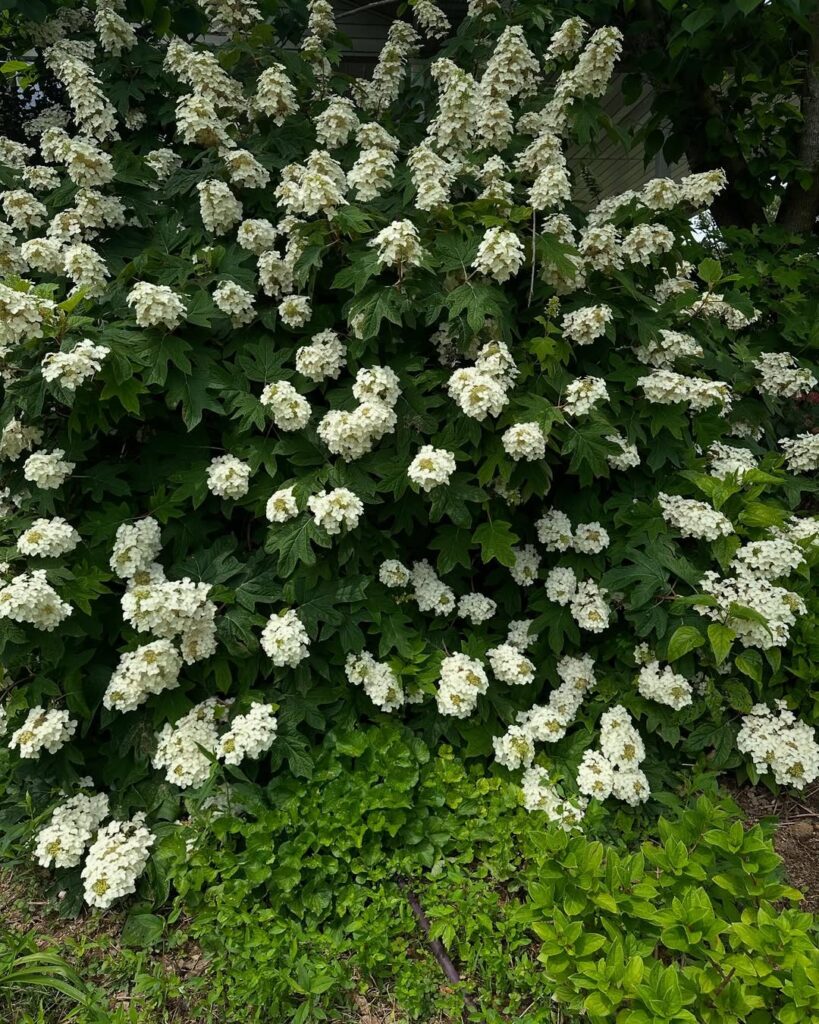
The Oakleaf Hydrangea is Alabama’s state wildflower and a versatile native shrub reaching 4-8 feet tall with distinctive oak-shaped leaves. Its mound-like form features exfoliating bark and conical flower clusters that shift from creamy white to rose-pink throughout summer. This low-maintenance shrub provides year-round interest with bold summer foliage, excellent fall color in deep reds and purples, and striking winter bark. Notable cultivars include ‘Snowflake’ with double flowers and compact ‘Pee Wee’ for smaller spaces.
- Hardiness: USDA zones 5-9; highly heat tolerant and well-adapted to Alabama’s climate
- Light: Full sun to full shade; performs well in various light conditions
- Water: Moderate moisture needs; prefers consistent watering but drought tolerant once established
- Soil: Adaptable to various soil types; prefers moist, well-drained conditions
- Fertilizer: Low fertilizer requirements; benefits from organic matter or compost
- Pest/Disease Resistance: Highly resistant to pests and diseases; very reliable
- Growth Rate: Moderate growth rate; reaches mature size within 3-5 years
Beyond its ornamental value, this native shrub provides essential food for butterflies and supports various pollinators and birds, making it an excellent choice for wildlife-friendly gardens.
Elderberry
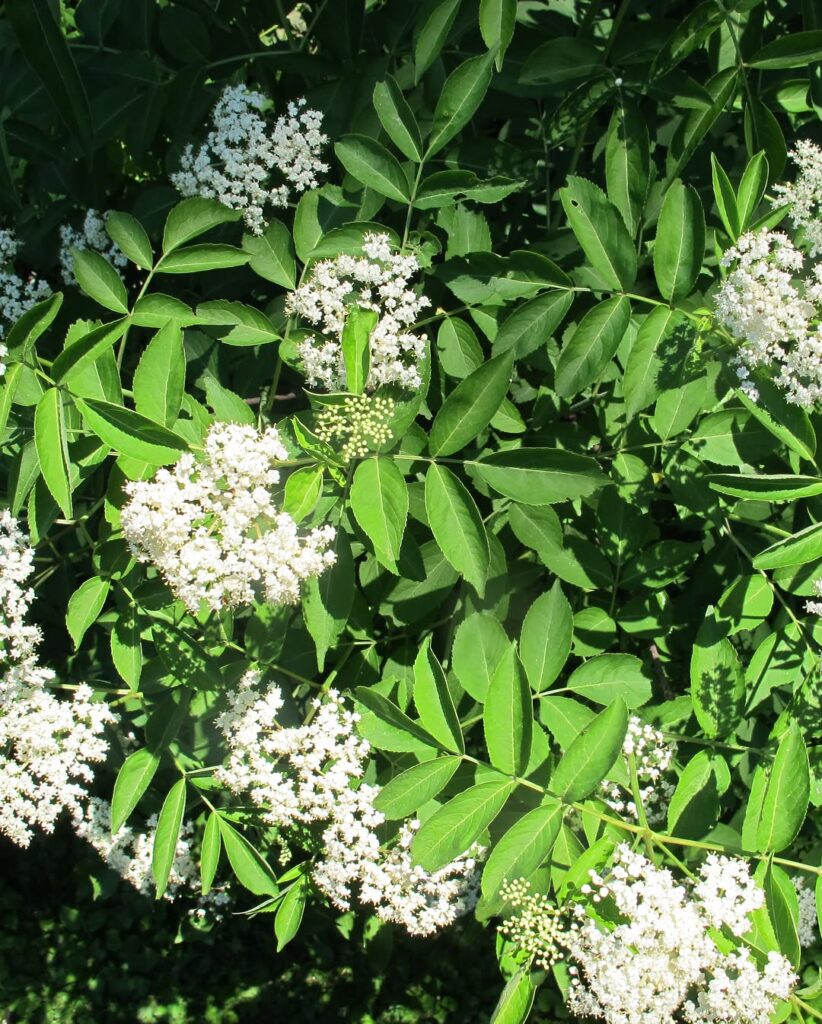
Elderberry (Sambucus canadensis) is a graceful native deciduous shrub belonging to the Haw family that reaches 5-12 feet in height with an equally wide spread. This versatile plant features arching stems, pinnate leaves with serrated edges, and produces clusters of white flowers in late spring followed by dark purple-black berries.
Beyond its ornamental value, elderberry serves as an exceptional wildlife plant, attracting pollinators and providing food and nesting habitat for numerous bird species while offering edible fruit for human consumption. The species demonstrates remarkable adaptability to disturbed areas, roadsides, and forest edges throughout its range.
- Hardiness: Thrives throughout all Alabama regions including Coastal, Piedmont, and Mountain zones
- Light: Full sun to partial shade (2-6 hours of direct sunlight daily)
- Water: Prefers consistently moist conditions but tolerates occasional wet areas and drier upland soils with good drainage
- Soil: Adapts to various soil types including clay, sand, and loam; prefers rich, moist, slightly acidic soil
- Fertilizer: Medium maintenance requirements with no specific fertilizer needs mentioned
- Pest/Disease Resistance: Generally hardy with good adaptability to diverse growing conditions
- Growth Rate: Medium growth rate
Wild Azalea
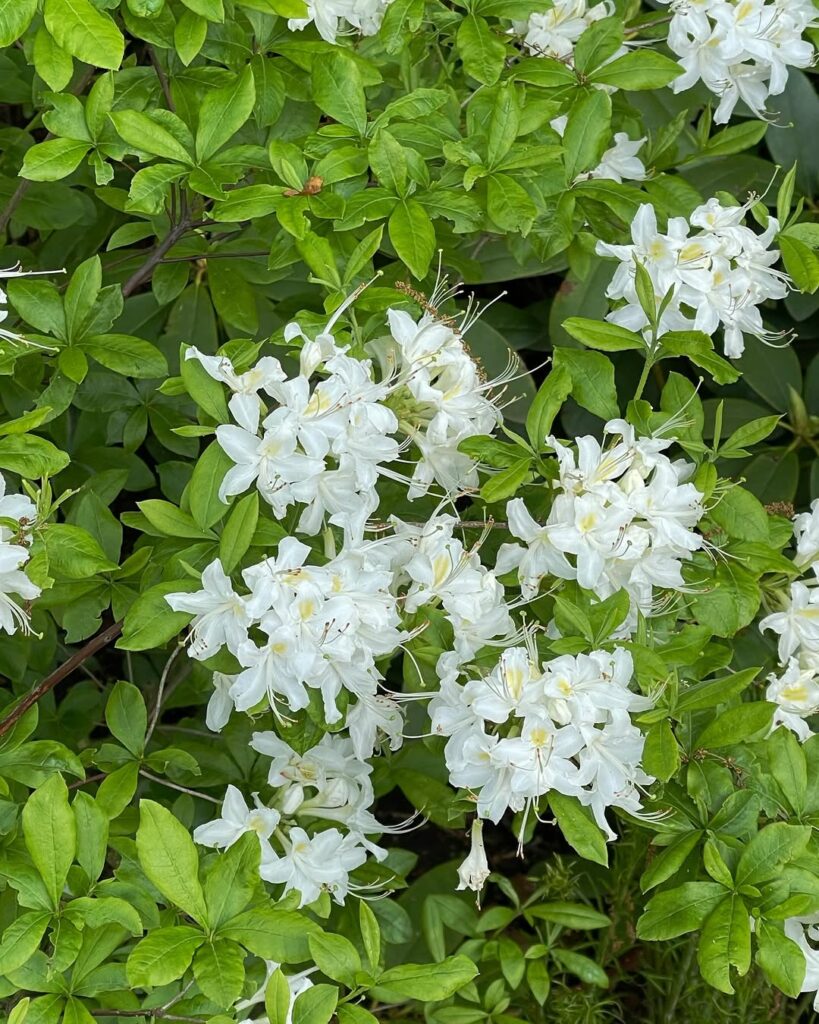
Wild Azalea stands as one of Alabama’s most treasured native shrubs, naturally occurring in the woodlands of Alabama and Georgia. This deciduous beauty reaches 4-6 feet in height and width, forming an open, upright habit rather than dense mounds. The spectacular white flowers feature prominent yellow blotches and emit a distinctive lemon fragrance that attracts pollinators during midseason blooming.
Unlike Asian azalea varieties, Wild Azalea loses its leaves in fall and spreads via underground runners to form natural colonies. The trumpet-shaped flowers appear before leaves fully mature, creating a stunning early season display. This low-maintenance shrub serves important ecological functions, supporting beneficial insects while adding ornamental value to native plant landscapes throughout the Southeast. Gardeners may discover natural crosses occurring in wild populations due to pollen transfer between different azalea species blooming in the same area.
- Hardiness: USDA Zones 7a-8b
- Light: Partial shade with protection from afternoon sun
- Water: Consistent moisture with well-drained conditions
- Soil: Acidic (pH below 6.0), well-drained soil with loam, sand, and organic matter
- Fertilizer: Low maintenance once established; benefits from annual mulching
- Pest/Disease Resistance: Generally resilient when grown in proper conditions
- Growth Rate: Medium growth rate
Selecting the Right Native Plants for Your Garden
How do you choose the perfect native plants that’ll thrive in Alabama’s unique climate and soil conditions? Start by evaluating your garden’s sun exposure, soil type, and moisture levels. Full-sun areas work best for coneflowers and tickseeds, while shaded spots favor Indian Pink and Wild Ginger.
Consider your garden design goals and desired native plant benefits. Trees like Red Buckeye provide spring hummingbird attraction, while Black Tupelo offers fall color. Shrubs such as Oakleaf Hydrangea create structure with seasonal interest.
Match plants to specific conditions: Pink Muhly Grass thrives in well-drained areas, whereas White Topped Sedge prefers moist locations for ideal growth. For areas with acidic soils, consider the Many-Flowered Grass-Pink, an elegant orchid that produces delicate pink flowers in early spring.
Frequently Asked Questions
How Often Should I Water Newly Planted Native Alabama Plants?
Like thirsty newborns, you’ll need daily watering techniques during the first month for ideal plant growth, then reduce to twice weekly. After establishment, your native Alabama plants become drought warriors requiring minimal water.
When Is the Best Time to Plant Native Species in Alabama?
You’ll find fall’s your ideal planting season for Alabama natives, typically September through November. Climate considerations favor this timing because cooler air reduces plant stress while warm soil promotes strong root development before winter arrives.
Do Alabama Native Plants Require Special Fertilizers or Soil Amendments?
Like resilient wildcats, Alabama natives don’t need pampering—they’ve mastered native soil requirements naturally. You’ll rarely need special fertilizers; simple organic fertilization methods like compost work best when soil testing actually indicates deficiencies.
How Do I Protect Native Plants From Common Alabama Pests and Diseases?
You’ll achieve effective pest management through proper plant spacing and regular monitoring. Disease prevention starts with selecting well-adapted native species for your specific hardiness zone and sunlight conditions, reducing intervention needs naturally.
Where Can I Purchase Native Alabama Plants and Seeds Locally?
You can find authentic Alabama natives at local nurseries like Nemophily Natives in Auburn or Recreative Natives in Cropwell. Check conservation organizations for native plant sales, or explore online retailers like Garden for Wildlife.
